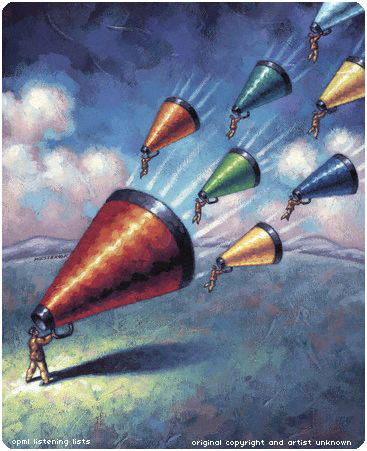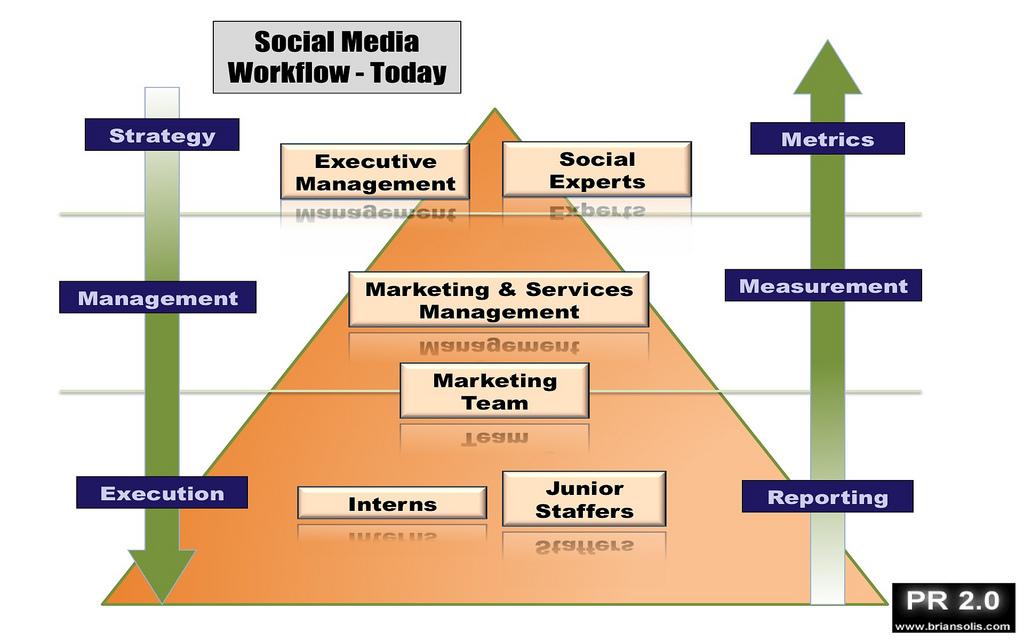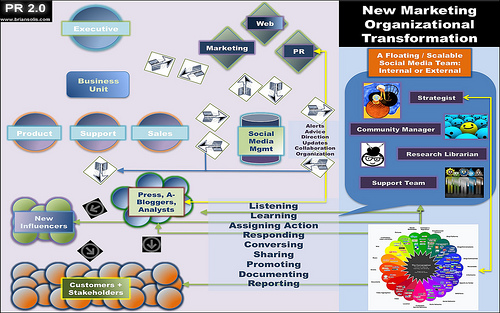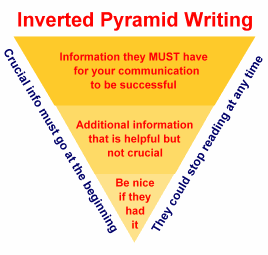Part II (cont.)
Click here to read “The State of PR, Marketing, and Communications: You are the Future (Part I)”
Public Relations Is So Much More Than Media, Analyst and Blogger Relations

Credit: Ghedo
The business of public relaltions slowly evolved away from public interaction and eventually transformed into a mechanism of media, analyst and blogger relations to instill messages and attempt to manipulate public behavior.
Public Relations = Publicity
This view of public relations can be traced all the way back to Edward Bernays in the early 1900s. A nephew of Sigmund Freud, Bernays experimented with Freud’s ideology related to people’s unconscious, psychological motivations and how they could be exploited or steered through communications and top-down influence. As a result, public relations of today is more aligned with media, analyst and blogger relations and not necessarily “public” relations.
Now that the creation and distribution of content has been democratized, everyday people are earning a level of authority that fundamentally works against the current model of current public relations.
As described in my book with Deirdre Breakenridge, “Putting the Public Back in Public Relations,” the Web, heightened by the proliferation of the read/write Web and the impending semantic Web, is forcing the integration of the “Public” back into Public Relations.
Applying the current process of pitch development and distribution has little to no impact on your numbers and your potential to survive the evolution of communications. In fact, this process works against you by alienating you and the brands you represent, closing valuable inroads to reach the very people who can make or break your business.
By simply adding bloggers to your mail merge or your “hit” lists, you are not adapting to the new landscape of influence and engagement, only contributing to its state of crisis. Bloggers are people too, and their in-boxes are just as chaotic as those of their journalist counterparts.
�
 Source
Source
Social media is bigger than simply integrating a “blogger relations” branch to your public relations strategy. It’s an opportunity to engage directly customers and peers who either purchase or recommend the decisions of others. Engaging and inspiring these individuals requires new techniques, methodologies, and an undeniable understanding of who they write for and why they should care about what you represent.
The new world of influence demands customer empathy, evangelism, passion, expertise and knowledge — everything else is disposable and takes away from your focus and potential.
Doc Searls spotlighted the people who define our audience on the other side of our messaging megaphones to magnify the reality that markets are conversations and that there really is no discernible market for our pitches and messages.
Over the years, my experience with direct engagement has revealed that conversations are also markets — within vertical segments. Traditional word-of-mouth, at the consumer level, is intensified as impassioned individuals now have access to new media that directly and indirectly influence the decisions of their peers in the real world and through their extended communities online.
So how does public relations attempt to engage with these new influencers?
Other than pitching at them and broadcasting messages through any and all channels and networks, many public relations people attempt to either pose as “users” or offer boilerplate comments and reviews across the blogosphere, in micromedia communities, online groups, and social profiles and review sites. This isn’t participation. This is public relations of old. It embodies the same spin that defines most press releases, along with the disingenuous voices associated with ghost-written executive quotes, contributed articles and now blog posts.
Listen, engage, prioritize and grow in the communities that affect your development, reputation, relationships and authority as a person and as a professional. It’s the only way …
Listening is the fundamental characteristic that separates the experts from the theorists.
The process of actively observing and documenting relevant conversations not only enables the communications team to create an accurate social map of important and relevant networks, but it also produces a more informed and empathetic assembly of sincere, humanized evangelists and ambassadors. This is a critical observation and lesson. We emerge from the process of listening and internalizing in tune and in touch with our markets and the people who define and direct them.
Blasting messages to them now seems trivial and purposeless. Engaging, solving problems and answering questions, essentially becoming community and customer resources becomes paramount and natural. We participate as consumers, and ultimately as the customers we wish to reach. It fuses customer service and influence. As next generation communications professionals, we’re walking a tightrope between earning attention and building community, without losing sight of our ultimate goal of propagating our value propositions.
It is the job of any good public relations professional to identify and guide influential voices within important online communities.
Transparency Begets Authenticity; Experience Engenders Authority, and Influence
Transparency scares the sh!t out of public relations people. This is an industry that has long operated behind the puppet master’s curtain, pulling the strings for spokespeople and varying communications tools to broadcast content at, around and through the back channel of influence, but never directly connecting with the people who define its audiences.
The democratization of content also dictates the success, “shareability” and permeation of your story by revealing and refining it through public forums and channels — let the community guide how you approach them.
The social Web forces you to participate as an individual, not as a marketer, and thus requires a new depth of understanding, expertise and knowledge in order to establish a meaningful relationship between customers, influencers, and the company and products you represent.

�
Whether you post a comment, write a blog post, upload a video, create a profile on a social network, or establish groups or fan pages, everything is now open to public dissemination, interpretation and response. E-mail, too, long considered a safe medium for exchanging or presenting information, is now backfiring for public relations, fueling bloggers and media to respond with a deep-seeded necessity to seek retribution by posting of original pitches and creating public blacklists that absolutely devastate public relations individuals and their standing within their respective industries. While I don’t agree with public humiliation, it is an unfortunate reality that we must contend with while fighting and promoting the ethics of human relationships. Nonetheless, the lesson here is that we are now forced to change how we approach people with our stories. It’s for our own good and the overall betterment of our craft.
A New Business Model and Infrastructure for Public Relations

Credit: Pear Biter
At South by Southwest (SXSW) in March 2009, Erin Portman, Karly Hand, Peter Shankman and I participated in a highly anticipated and heavily attended session entitled, “Are PR Agencies Dead?”
Some people would object to the use of “dead” in the title of anything these days. But is it really a tired discussion in the grand scheme of things? Maybe it’s stale to those who ping pong the discussion in the echo chamber. But for the rest of the world, it’s a topic that is either new or soon to be introduced into their world.
The controversial session explored whether or not social media was killing public relations or breathing new life into it. In the end, it’s actually a bit of both. And along with it, social media is forcing the establishment of new business models, staffing infrastructures and service portfolios.
To be clear, the practice of blindly broadcasting messages through poorly written press releases at audiences is dead. Public relations is NOT necessarily dead, but without the application of a social tourniquet, it is bleeding to death.
Essentially, this is a matter of livelihood, and the evolution of marketing and public relations is incredibly poignant to each and every one of us.
At the end of the day, we are now in the business of visibility, influence and perception management. So we can now put away the white coats associated with spin doctoring. We can remove the blindfolds we wore in every mass blast we sent. And we can hang up our plaid jackets associated with the snake oil salesmanship we were accused of oozing in every exchange.
We now need to rethink our roles as intermediaries between the companies we represent, authorities, and ultimately the communities that determine our place in the market. In order to persevere and excel, agencies, and the individuals who define them, must act as thought leaders and market makers, serving both sides of the conversation and also the ensuing activity and interaction.
The business model of billing for hours as related to press release writing, account management, news pitching and traditional counseling is growing increasingly irrelevant in the face of new services and competition that public relations never saw coming.
Suddenly we’re competing against interactive, advertising and digital agencies, community management teams, social media agencies, experiential specialists, branding and marketing consultants, or hybrid organizations combining all of the above.
Honestly, up until this point, we weren’t hired or paid, by in large, to connect, advocate, influence or believe; we were rewarded by the placements that result from mass pitching. When you run a campaign around “hits,” then it’s crafted and governed by numbers, not people.
As I mentioned during the panel, the public relations/new media agency that I run no longer bills for press release writing, account management or standard pitching. These are now functions of more relevant social + traditional outreach and engagement programs. In fact, over the last decade, we’ve completely redesigned our services infrastructure to reflect the real world business needs and goals of the companies we represent. It’s not absolutely definitive, but a promising work in progress that is very monetizable now and in the long term.
However, it requires not only new and conclusive services that combine standard communications and new media strategies, but also the associated metrics that justify the newer activity. In order to balance the new programming, we also shifted our billable infrastructure from a top-down agency model to a flat organization consisting of experts in the fields we represent, as well as those who are fluent in the tools, channels and supporting cultures that foster influencer and customer interaction. Basically, we detonated the old infrastructure, kept the pieces that have and will always work, and connected everything to the new programs where we’re already seeing value today.
Ctrl-Alt-Del
There is no doubt in my mind that eventually all public relations agencies and consultants will follow suit and transform from publicity firms into new media communications and marketing organizations rich with in-house or contracted content producers, digital sociologists, research librarians, community managers, digital architects, connectors and industry experts/strategists.
But everything hinges on the ability to interpret trends, assess value and metrics, intelligently engage, and ultimately inspire change through proven results.
The function of socializing media within the organization could be relegated to a team of dedicated specialists before it’s deployed company- or agency-wide.

�
Real-time responsibilities (fully transparent and disclosed) of a new media team could include:
Content Producers — Create content necessary for client/company interaction with customers, peers and influencers, including videos, images, Web pages, blog posts, policies and guidelines, tweets, wikis, comments, online experiences, profiles, etc. In many cases, connectors and industry experts/strategists wear this hat and assign the creation of important content to either content producers, other members on the team with direct experience, or simply produce it themselves.
Digital Sociologists — Observe the cultures, trends, behavior associated with communities, networks, forums, and compare the interactivity around keywords and brands to contribute to engagement strategies, customer service policies, and improvements and product modifications.
Digital Ethnographers — Ethnography is the branch of anthropology that deals with the scientific description of specific human cultures. For those projects where a deep study of online culture and communities is critical, an ethnographer is ideal for documenting a descriptive study of a particular human society. As ethnography is based almost entirely on fieldwork, this role usually lives and interacts with the people who are the subject of study.
Research Librarians — Complement or augment in-house or contract sociologists by analyzing relevant keywords used by customers, listening to and documenting conversations by content and sentiment, charting volume and frequency within social networks, identification and analysis of true influencers and tastemakers across media, blogs and social communities, and present data and charts for analysis by strategists.
Community Managers — Listen to conversations in social networks, forums and the blogosphere documented by research librarians or through their own process; assign relevant dialogue to appropriate team leads; manage the workflow and response status; and in most cases are the first line of response.
Digital or Social Architects — Digital or social architects are responsible for building the online bridges between company brand and consumers via widgets, sites, online dashboards, blogs, social newsrooms, social media releases, wikis, social networks, fan pages, forums, groups, and any other application, platform or group responsible for hosting content, conversations and interactivity.
Connectors — Informed individuals and teams that can connect stories to influencers and inspire activity, direction and conversations. Connectors act based on intelligence, empathy, sincerity and the ability to truly “bridge” a story to someone else in a way that’s specific and compelling to them as an individual, and also as it relates to their audience and social graph.
Industry Experts/Strategists — Someone has to act as the conductor to this allstar orchestra. Qualified individuals have mastered the art and science of attaching new and traditional media to the bottom line of their business, and also possess a deep understanding of and experience with customer empathy, market trends and the governing technology that connects the people within desired marketplaces.
Yes, I said customer empathy …
As I said in the SXSW panel, which the Los Angeles Times picked up, “Get a little empathy going on. Putting an ear to the virtual ground will tell you everything you need to know — it’s going to affect and influence what you write, how you talk. It’s going to make you a little more passionate, a little more believable.”
These new, adjoined job functions create a new level of services that complement existing, traditional and necessary communications activities:
- Listening/Monitoring/Documenting — intelligence gathering and trend analysis
- Engagement in the networks and groups where relevant conversations are pervasive and warrant participation
- Content creation
- Conversation management and trafficking
- Influencer and tastemaker identification and networking
- Community management, empowerment and cultivation
- Event hosting and franchising
- Story development and connectivity to “The Magic Middle” bloggers and Long Tail networks
- Humanizing company and product messaging and redefining the online journey and experience associated with the online presences associated with specific brands/products
The opportunities are limited only by the imagination of those responsible for engendering change from within.
Becoming the People You Want to Reach
In a recent survey conducted by the Institute for PR, most (92 percent — up from 89 percent in 2008) of those surveyed believe that blogs and social media influence news coverage in the traditional media (newspapers, magazines, radio and television). They most certainly influence the purchase decisions of customers.
But how do you spark word-of-mouth across the social Web? How do you socialize relevant information across the social graphs of those who define your relevant networks?
Communities won’t react to a press release. Nor will communications professionals galvanize action because of a generic pitch.
They need inspiration and motivation, and that can only stem from an interaction that is so compelling and engaging that they’re inspired to act and share. Essentially, you have to become the people you wish to reach and excite.
Yes, transparency subjects you to public scrutiny. It also forces you to rethink your approach and the words you share with those you believe are qualified and amenable to hear them. It raises the bar and hopefully inspires a more personal and human interpretation tied to the nuances of the individuals you’re attempting to convince and inspirit.
When we start writing that pitch or crafting the first draft of the press release, we seem to lose touch with our inner consumer in favor of appeasing corporate management. But ultimately, who are we writing for?
It’s a delicate line to traverse.
On one side of the equation, you serve the people that ensure you have a job; on the other side, you’re faced with a discerning group of influencers and ultimately people who communicate through experiences, pains and benefits, and not hyperbole and innovations.
It’s as simple as this — stop speaking through pitch e-mails and press releases designed to satisfy the people who most likely don’t or won’t buy the product or service.
Do you really think that speaking in marketing tongues is what it takes to get someone to pay attention to you — especially in this attention economy?
If you talked to your friends and family the way you pitch reporters and bloggers, you’d get nowhere quickly. In fact, you’d lose face and favor. The same is true for public relations. You’re talking to real people, on their terms.
You are the customer.
Try starting with the #twitpitch. Based on the art of MicroPR, if you could summarize the story in 140 characters or less, then you’re well on your way to commanding the escalator pitch, which makes the elevator pitch seem like a luxury.
 Yes, this technique reverses the traditional inverted pyramid we’re so accustomed to using when writing any marketing material, particularly, press releases.
Yes, this technique reverses the traditional inverted pyramid we’re so accustomed to using when writing any marketing material, particularly, press releases.
�
But now we can say more with less. It’s the poetry and power of brevity — the art of persuasion through sincerity and relevance.
Here’s an interesting story I thought I’d share …
I’m working with a company that set me straight at the beginning of our relationship. While he had heard nothing but wonderful things about my team, he simply said, don’t sell me. I understand that you can get us in the press and the blogosphere and increase the frequency of conversations related to us across social networks. But I need you and your team, to be “us.” We created this product and company with our life’s passion, and I don’t need it pitched. I need it shared as a real solution for those with real pain as someone who truly lives and breathes it. I don’t want public relations; I need a dedicated team of enthusiasts that not only get it, but represent its incarnation.
His request is not unique.
Our Future and Your Place Within It Rests in Your HandsAfter a decade of sharing new philosophies, techniques, tools and strategies for evolving how we think about and practice new and traditional communications, it’s become quite clear to me that an industry firmly settled in history and process will not change in unison. It will take the influence of globally dispersed beacons representing a new hope for public relations who will champion the change from within and also from the outside. These individuals reside in public relations, but will also feature the emergence of collaborators and new competitors representing hybrids of interactive and Web marketing, customer service, technical and social architecture, digital sociology and research, evangelists, and community catalysts.
This higher level of commitment and supporting tactics are the minimum ante to practice public relations today and tomorrow — and its minimum will continually increase over time (as it should have all along). Personalized value and genuine, transparent and meaningful conversations are what it takes to forge relationships, and continued value, listening and sustained benefits, combined with a lot of YOU, is the emotional investment that nurtures loyalty and referrals.
As mentioned earlier, public relations and marketing will not change until it has to … now, there’s no choice. Public relations is broken, but it is far from dead. The good news is that tomorrow’s public relations strategies are already successfully practiced today. The architects of new communications are collaboratively building a bridge to the masses to help navigate a path to education and relevance, defining the future of public relations and socially aware marketing in the process.
Change is imminent, and its traction and fate is tied to you.
GapingVoidIf it’s one moral that I want you to embody after reading this paper, it’s that YOU, and only you, are in control of your career and the ensuing success that you earn and deserve.
You have to become the very people you’re trying to reach in order to effectively create connections and inspire action. Execution is defined by engagement, earned relationships and the ensuing activity that results from each interaction. You are involved at every point.
If you’re dedicated and resolved to learn, new thinking, case studies, education and insight are now a commodity on the Web. Everyone in this space is willing to help you, so take full advantage of it.
You learn, grow and excel on your terms.
We ARE becoming the new influencers, and therefore we must redesign the communications ecosystem in which we operate and our roles within it in order to change, grow and thrive.
Welcome to the new standard of public relations and marketing communications.
How will you contribute to its evolution and practice?
 Brian Solis is the principal of FutureWorks, an online public relations/communications firm he founded in 1999. He is a co-founder of the Social Media Club, a national organization that convenes events for the purpose of sharing best practices, establishing standards and promoting social media literacy. He is an original member of the Media 2.0 Workgroup and also contributes to the Social Media Collective. He recently co-authored “Putting the Public Back in Public Relations” (March 2009 FT Press). Connect with Brian on Twitter, FriendFeed, LinkedIn, Tumblr, Plurk, Identi.ca, BackType or on Facebook.
Brian Solis is the principal of FutureWorks, an online public relations/communications firm he founded in 1999. He is a co-founder of the Social Media Club, a national organization that convenes events for the purpose of sharing best practices, establishing standards and promoting social media literacy. He is an original member of the Media 2.0 Workgroup and also contributes to the Social Media Collective. He recently co-authored “Putting the Public Back in Public Relations” (March 2009 FT Press). Connect with Brian on Twitter, FriendFeed, LinkedIn, Tumblr, Plurk, Identi.ca, BackType or on Facebook.
Join Brian at the Meet the Experts networking session and “Putting the Public Back in Public Relations in PR” co-author, Deidre Breakenridge, along with Joseph Jaffe, Juliette Powell and Ariel Hyatt, for the panel discussion, “Social Media and the PR (R)Evolution: It’s Not Just PR Anymore,” at the PRSA 2009 International Conference: Delivering Value, November 7-10 in San Diego, CA!






